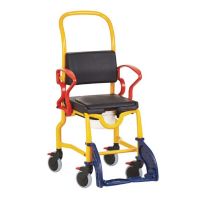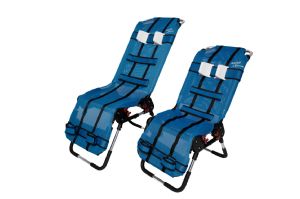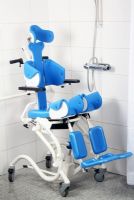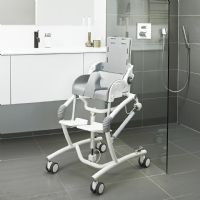 Written by Heather Collins, MSN, RN, CNOR
Written by Heather Collins, MSN, RN, CNOR
According to Standford Medicine, an estimated 2.2 million children aged 14 and under are treated annually at hospital emergency rooms for fall-related injuries. This number is staggering- and while all falls can’t be prevented, certain measures can be taken to reduce overall pediatric fall risk. With slippery bathrooms posing one of the greatest threats, particularly for children with mobility issues, it's imperative that our environments are set up to enhance safety and security.
Showering, toileting and their associated movements are the riskiest bathroom-related activities due to the deep transfers and slick surfaces involved. Easing the burden of these tasks involves an appropriate environmental setup and well-fitting assistive devices to meet the individual’s unique needs. From shower chairs to grab bars to commodes, there are a plethora of well-designed products curated to promote independence and overall safety. Today we’re taking a deep dive into the world of shower chairs, including the various options available for the pediatric population and how to choose the best device for your child’s unique needs.
Shower chairs, also known as bath chairs or shower seats, are specially designed seats made of water-resistant materials. They are carefully crafted to improve user safety and enhance comfort and confidence while in the shower. Meant to maintain dignity, they are appropriate for a variety of populations including those with reduced mobility, acute injuries, and other conditions that make showering challenging.
The use of a shower chair is elegantly simple. The seat is placed directly into the shower in whatever position is most comfortable for the user. To optimize safety, it’s important that all four legs are in direct contact with the floor and the device is entirely stable. Ensure all hazardous objects are removed from the vicinity and rubber caps are applied to the legs to minimize chair slippage. Once the chair is stationary, the user simply sits in the center of the seat and carries out showering activities either independently or with the assistance of a parent or caregiver.
 | Rebotec Augsburg Pediatric Shower Commode Chair View Product |
Matching our kiddos' unique needs, shower chairs come in a variety of shapes and sizes. Choosing the best device for your child will depend on their overall movement abilities, head and trunk control, and your specific home setup. The first option available includes a rolling shower commode chair that is highly flexible and allows for seamless mobility between various areas and rooms. They are particularly useful for individuals who have difficulty with independent maneuvering in and out of the shower and those with general mobility dysfunctions. Given the wheeled mobility of this device, it provides caregivers significant relief while performing shower transfer activities. Please note, that because of the setup of the chair, it is helpful to have a curbless or low-threshold entry into your shower in order to make the transfer with ease.
Best: Rebotec Augsburg Pediatric Shower Commode Chair
 | Anchor Pediatric Specialty Needs Bath Chair View Product |
Stationary shower chairs are a second option and perhaps the most familiar of the shower seat selections. They are placed directly into the shower and then transferred either independently or with the assistance of a slide board or caregiver. While they lack mobility and flexibility, they have a stable base and offer the child significant support once they are in the tub.
Best: Anchor Pediatric Specialty Needs Bath Chair
 | Zitzi Starfish Pro All Ages Shower and Commode Chair View Product |
Providing optimized comfort and a high level of customization, adjustable shower chairs are a great option for those looking to fit a child’s unique needs. With multiple points of adjustability, they can grow with the child over time and accommodate changing stability and mobility demands.
Best: Zitzi Starfish Pro All Ages Shower and Commode Chair
 | Flamingo Tilt-in-Space Shower and Commode Chair View Product |
Similar to a tilt-in-space wheelchair, tilt-in-space shower chairs recline the user backward while maintaining the body’s overall position. This option can be very helpful for populations with poor head and trunk control and can ease the burden on caregivers while performing bathing activities.
Best: Flamingo Tilt-in-Space Shower and Commode Chair
.jpg&newwidth=365&maxheight=200) | R82 Flamingo Shower Commode Chair View Product |
If transportability is important to you, portable shower chairs are a final option that gives users the freedom to travel and adapt to various shower environments. With several distinctive designs, some are created to fold in on themselves while others can split into smaller removable pieces. Regardless of the setup, they provide freedom of movement, compact storage, and the ability to support your loved one wherever life takes you.
Best: R82 Flamingo Shower Commode Chair
With so many options on the market today, finding the best device for your child relies on a few key features. The first feature to consider is size and weight capacity. Whether your child is 3 years old or 18 years old, ensure that the child falls within the weight requirements and the chair can adequately support the user.
If your child or patient has certain positioning needs, choosing a chair with appropriate accommodations is the next key feature. Shower chairs range from standard stationary chairs to highly adjustable versions providing consumers with versatility and adaptability to meet each individual’s unique scenario. Whether you’re looking for a reclining seat or flexible supports and straps, find a device that gives your child the support they need to maximize their confidence and comfort while showering.
When it comes to shower entry, there are two primary options, rolling and stationary chairs, that provide varying benefits to the child. With greater mobility and flexibility, rolling chairs give a higher degree of support during the shower transfer process and are better suited for more dependent children. That said, while stationary chairs require greater independence from the patient, they are great options for those looking to maximize stability and safety when a rolling entry isn’t required.
Especially important with our pediatric populations, size adjustability is a key factor to maximize the longevity of your shower chair device. If your child is young or you’re anticipating imminent growth spurts, make sure to choose a product with both height and seat width adjustability to meet his or her growing needs.
Shower chairs come in a variety of wood, aluminum, and steel options. While wood may be aesthetically pleasing, it can be more challenging to clean and maintain over time. If you’re looking for durability, a chair made of steel or aluminum will likely last longer and keep your child safe and supported for years to come.
A final feature to consider is toileting versatility. With many bathroom chairs constructed as a commode-chair combination, it can be very helpful to get a device that serves dual purposes, particularly for those that need support during both showering and toileting. If toileting support is not necessary for your child, consider a device without a commode opening to enhance user comfort.
Place the shower chair in the desired part of the shower with the base in full contact with the shower floor. If the user is showering independently, make sure the chair is placed where the water will hit the user and all hygiene items are within arm’s reach. If the user will require assistance set the chair in a position that allows appropriate water flow while maintaining ergonomic posture for the providing caregiver.
Generally speaking, pediatric shower chairs can be cleaned with a mild household cleaner and a sponge. That said, it's advisable to consult your user manual prior to disinfecting as certain models have special cleaning instructions.
Absolutely! Transfer benches and grab bars are both viable alternatives that offer similar benefits in different formats. Ultimately the best assistive device for your child comes down to the home environment, individual support requirements, and user mobility.
Although each product has a unique lifespan, they are designed for bathroom conditions and are typically quite durable to last many years.
Every shower chair should have at least a few inches of free space on all sides to ensure user comfort and device stability. You want to provide ample room for the chair to sit and for the user to be able to move around if needed. Keep in mind when measuring your shower or tub that some are slightly concave with the clearance at the bottom smaller than the clearance at the top. Refer to your desired product manual for specific product dimensions.
Maintaining the safety and dignity of our loved ones during showering is imperative to optimize their quality of life. Shower chairs provide both users and caregivers with increased comfort and confidence during showering and reduce the risk of bathroom-related falls and injuries. With a plethora of devices on the market today, you can find a product that meets just about any individual need.
Our children deserve to feel safe, supported, and confident in their activities of daily living. If you’re interested in learning more about shower chair options, check out our full listing of devices here. While you’re there, feel free to browse through Caregiver University, our expert-curated informational portal that includes buying guides, blog posts, and research-driven content to help you make the most informed buying decisions.

Heather Collins, MSN, RN, CNOR
Heather is a registered nurse and freelance health writer with a Master's degree and over 24 years of nursing and leadership experience. Heather cares for patients of all ages in various healthcare settings, including inpatient acute care nursing, GI procedural nursing, cardiac lab, infertility clinics, pediatrics, and surgical services. Heather is dedicated to providing high-quality care and sharing reliable, evidence-based information that empowers people to make informed decisions about their and their loved ones' health.